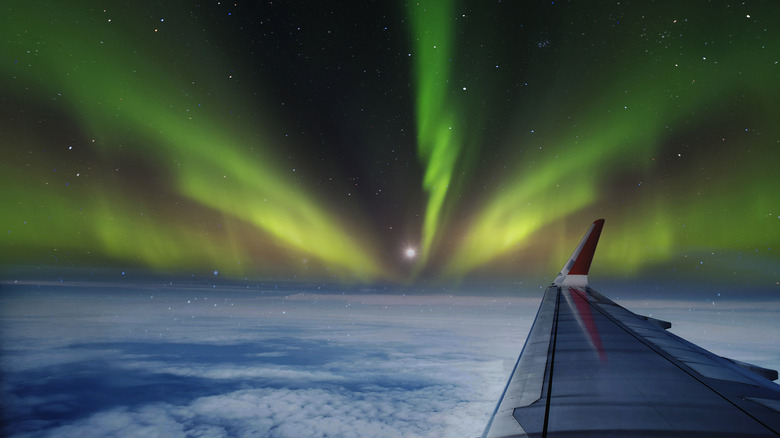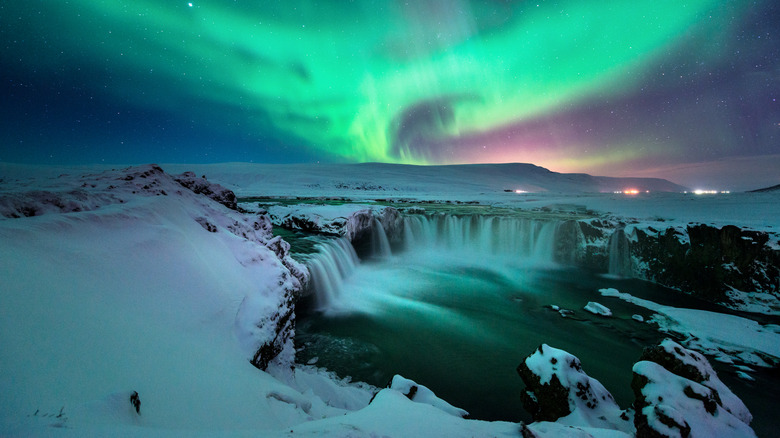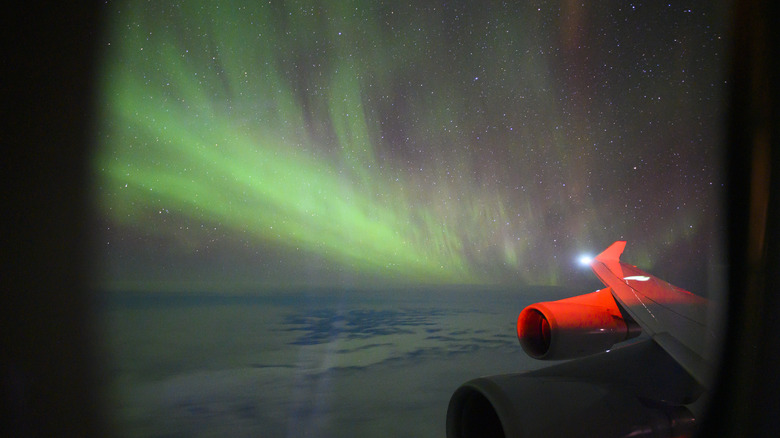Want To See The Northern Lights From The Sky? These Flight Routes Are Your Best Bet
Ahh, the northern lights! Could nature offer a more captivating, serene experience? While witnessing this splendid display of color and lights from any point of view is awe-inspiring, there's no better place to be than in the middle of all the action while airborne. If you do your research ahead of time, you might just have a chance of catching a dazzling solar show out the window. Observing the lights from the plane offers an unparalleled up-close perspective. With less air pollution above the clouds, travelers have a visible, unobstructed view of the lights from their position in the air.
The months between September and April are often the best time to book a trip in the hopes of catching a glimpse of the beautiful color show that dances across the northern skylines. As the nights become darker and daylight hours are diminished, the blackness of the sky provides optimal conditions for viewing the aurora borealis. In regions far enough north there's hardly any daylight at all, a phenomenon known as the "polar nights."
When selecting flight paths that give you the best chance of witnessing this spectacular display, aim for routes to Scandinavian countries like Iceland, Norway, Sweden, Finland, and Denmark. You can also catch the aurora borealis in northern Canada and even the United States, in Alaska. These areas are the most prevalent for viewing geomagnetic activity, which is due to be particularly strong over the next few years.
Flights routes with the best viewing opportunities
Winter is the best time to visit Iceland and other northern regions to see the aurora borealis as there's more solar activity and more hours of darkness. Being mindful of when you choose to fly offers an increased opportunity to catch the northern lights from the plane window. As grueling as they may be, make sure you book an overnight flight, as the lights can only be viewed when the sky is dark.
Flight paths that cross Canada and the North Atlantic Ocean offer the highest likelihood of great sightings. Icelandair offers several direct flights to Reykjavik from major international airports in the United States, including Seattle, Chicago, New York, Boston, and Orlando. Icelandair and Air Greenland also offer flights between Reykjavik and various destinations around Greenland, which you could visit for another chance to see the northern lights from the plane and an intrepid adventure in this lesser-visited northern region of Denmark.
Finnair offers direct flights from Los Angeles, New York, Miami, and Dallas to Helsinki, Finland, and Scandinavian Airlines System (SAS) runs one direct route between New York and Oslo, Norway. Flights between New York and Stockholm, Sweden, are available through airlines like Delta, Air France, and KLM. Canada is another excellent place to visit when searching for the aurora borealis, and you won't need to travel as far. Flying to destinations in the northern part of the country such as Yellowknife, Whitehorse, and Iqaluit, offers the best viewing opportunities. If you want to keep travel domestic, consider one of the many flight routes to Alaska.
How to see the northern lights from the plane
There's no way to guarantee an aurora borealis sighting, as it's a natural phenomenon and visibility relies on several weather factors that can change before or during your flight. But there are some steps you can take to increase your chances of getting a good view if the lights do come out to play.
When booking your flight, make sure to choose a window seat. You may also want to pick a seat with a view that isn't obstructed by the plane wing, such as one at the very front or very back. Snagging a window on the north-facing side of the plane will give you the best views, so consider the plane's path before making your selection. For example, if you're flying east from New York to Reykjavik, you will want to sit on the left side of the plane so your window is facing north for the majority of the trip.
Once you're on the plane, you can let the flight attendants know you're hoping to see the northern lights and ask them to give you a heads-up if they spot them. Pilots sometimes make an announcement if they're in full swing, as well. And what's the point of setting yourself up with a world-class view if you aren't able to document it in a high-quality fashion? With today's innovative technology, your smartphone camera will do the trick, but you simply can't beat the quality of a DSLR in low-lighting conditions.


